基础
上一章《入门》指导了安装和创建新乐谱的步骤。本章将介绍 MuseScore 的概况,以及制谱的基本操作。
Edit mode
Edit mode allows you to perform a wide range of editing operations on individual score elements, such as:
- adjust the length and shape of slurs, lines, barlines etc.
- add, delete and format text in text objects.
- adjust the position of most score elements (but not text).
Enter/exit edit mode
To enter Edit mode use any of the following methods:
- Double-click an element.
- Right-click on an element and, from the menu, select Edit Element.
- Click on an element and press Ctrl+E (Mac: Cmd+E).
To exit Edit mode use any of the following:
- Press Esc.
- Click on a blank area of the document window.
Text
For text edit mode, see Text editing.
Lines
Lines—such as slurs, ties, hairpins, voltas etc.— display square adjustment handles in Edit mode: these turn blue when selected. A slur, for example, looks like this:

The end handles are used to adjust the length of the line. The middle handle is used to adjust its vertical position. In the case of slurs and ties, there are also three more handles to adjust the shape of the curve (see image above).
To reposition a handle, click on it and use a keyboard shortcut (see below). Alternatively you can drag the handle with a mouse.
Each end handle is connected by a dotted line to an anchor on the staff. The start and end anchors mark the boundaries of the region of the score under the control of the line. By default, an end handle is positioned vertically above its anchor.
- To move both an end handle and its attached anchor: Click on the handle and use Shift+→ or Shift+←.
- To move an end handle without affecting its anchor: Click on the handle and use either the left/right keyboard arrows or a corresponding Ctrl (Mac: ⌘) command. See keyboard shortcuts below.
Notes
Offset notes
Sometimes it is necessary to shift a note to the right or left—to avoid a collision with another element or to override automatic notehead sharing for example:
- Enter Edit mode on the desired note;
- Press the arrow key in the direction (left or right) that you wish to nudge the note (or use Ctrl+← or Ctrl+→ for larger adjustments);
- Press the Esc key. This will allow the note stem to be redrawn.
Alternatively, you can select the notehead and change the "Horizontal offset" (under "Chord") in the Inspector.
Adjust note stem length
- Enter Edit mode on the desired note stem;
- Use keyboard shortcuts (below) to extend or shorten the stem;
- Exit edit mode.
Note: To reposition a note stem, you should select it and adjust the "Horizontal offset" in the Inspector.
Keyboard shortcuts
In Edit mode the following keyboard commands can be used to change the position of either (1) a score element (e.g. ornament, accidental etc.) or (2) an adjustment handle (e.g. slur, line etc.):
- ←: Move left 0.1 staff space.
- →: Move right 0.1 staff space
- ↑: Move up 0.1 staff space
- ↓: Move down 0.1 staff space
- Ctrl+← (Mac: ⌘+←): Move left one staff space
- Ctrl+→ (Mac: ⌘+→): Move right one staff space
- Ctrl+↑ (Mac: ⌘+↑): Move up one staff space
- Ctrl+↓ (Mac: ⌘+↓): Moves down one staff space
- Alt+←: Move left 0.01 staff space
- Alt+→: Move right 0.01 staff space
- Alt+↑: Move up 0.01 staff space
- Alt+↓: Move down 0.01 staff space
The following commands only apply to adjustment handles:
- Shift+←: Move end handle's anchor left by one note/rest.
- Shift+→: Move end handle's anchor right by one note/rest.
- Tab: Go to next handle.
See also
Palettes and workspaces
To the left of the document window is the Workspace. This can be toggled on and off using the menu command, View → Palettes, or the shortcut, F9.
A workspace, in turn, consists of a number of palettes. Each palette is a folder containing a group of musical symbols.
Workspaces
MuseScore provides two preset workspaces: Basic (the default option) and Advanced (a version with more palettes and symbols). These contain symbols drawn from the various sections of the Master palette. In addition, you can create your own custom workspaces (below).
- To switch between workspaces: Use the drop-down menu at the bottom of the workspace panel.
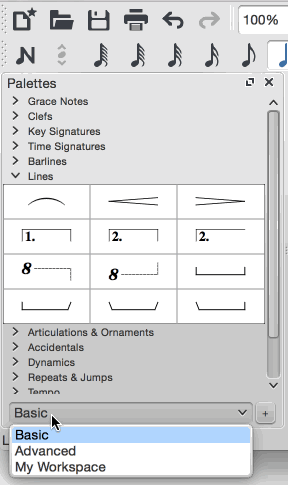
The names of palettes within a workspace are listed under the title "Palettes."
Single Palette Mode
If you only want to allow one palette to open at a time, right click at the top of the workspace and check the "Single palette" box. This will cause a palette to automatically close when you open a different one.
Docking/undocking
To dock or undock a workspace, see Side panels.
Custom workspace
A custom workspace allows you to select which palettes are listed, and to customize the contents of those palettes.
To create a customizable workspace:
- Select an existing workspace. Use the drop-down list at the bottom of the workspace panel if needed.
- Click the + button, enter a name for the new workspace and press OK. The new workspace is added to the panel.
Alternatively you can use the menu option:
- Select Edit → Workspaces, and chose a workspace.
- Select New. Fill in the new workspace name and click OK.
Right-clicking over the workspace will display a menu: this has options allowing you to insert, delete, rename and reorder the palettes within it. The contents of individual palettes can be edited in a similar fashion once you've checked "Enable Editing" for a palette. For more details, see Custom palettes and Palette menu (below).
Palettes
Open/close palette
- Click once on the name of the palette or its accompanying side-arrow.
Apply symbols from a palette
A palette symbol may be applied to the score using one of the following methods:
- Select one or more score elements and double click the palette symbol.
- Drag and drop the symbol onto the desired score element in the staff.
Tip: To prevent accidental rearrangement of contents during use, right-click over a palette name and untick "Enable Editing."
For example, to add tenuto marks (—) to a selection of notes:
- Select the desired notes.
- In the Articulations & Ornaments palette, double-click on the tenuto symbol
Once added to the score, objects can be copied, pasted, and duplicated—see Copy and paste.
Preset palettes (Advanced workspace)
The more fully-featured Advanced workspace contains the following palettes:
- Grace Notes
- Clefs
- Key Signatures
- Time Signatures
- Barlines
- Lines
- Arpeggios and Glissandi
- Breaths and pauses
- Brackets
- Articulations and Ornaments
- Accidentals
- Dynamics
- Fingering
- Note Heads
- Tremolo
- Repeats and Jumps
- Tempo
- Text
- Breaks and Spacers
- Bagpipe Embellishments
- Beam Properties
- Frames and Measures
- Fretboard Diagrams
Custom palettes
Once you have created a custom workspace (see above), and enabled editing (see Palette menu below), you can customize the palettes within it to your own requirements.
To add an existing score element (such as a line, text, dynamic, fretboard diagram etc.) to a custom palette:
- Press and hold Ctrl+Shift (Mac: Cmd+Shift), then drag the symbol onto the palette.
To add a symbol to a custom workspace from the Master palette:
- Drag the symbol from the Master Palette window into a custom palette.
To re-arrange a symbol in a custom palette:
- Drag the symbol to the cell you want it to display in: it will swap places with the symbol currently occupying that cell.
Palette menu
Right-clicking on the name of a palette in a custom workspace brings up this menu:
-
Palette Properties...: Adjust the appearance of the open palette:
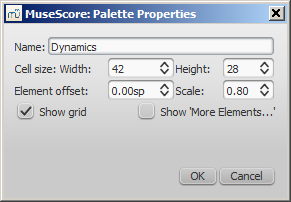
- Name
- Cell Size: Width, Height
- Element Offset: Adjust the vertical offset of all elements in the palette.
- Scale: Make all palette elements appear larger or smaller.
- Show grid: Visually divide the palette into cells, one for each element.
- Show ‘More Elements…’: Create a cell which opens the Master Palette.
- Insert New Palette: Create a new empty palette.
- Move Palette Up / Move Palette Down: Reorder the palettes.
- Enable Editing: Allow modifying the contents of the palette.
- Save Palette: Save as an .mpal file.
- Load Palette: Load an .mpal file.
- Delete Palette: Remove the palette from the workspace entirely.
Right-clicking on an element within a palette (if editing of the palette is enabled) brings up this menu:
- Clear: Remove the element from the palette
- Properties...: Open the Palette Cell Properties dialogue:
- Name: The tooltip that appears when you mouse over the element.
- Content offset (X, Y): Adjust the position of the element in the palette.
- Content scale: Make the element appear larger or smaller in the palette.
- Draw staff: Draw the five lines of a musical staff behind the palette element.
- More Elements: Open the relevant Master Palette section.
Note: Changing values in "Palette Cell Properties" only affects the appearance of elements in the palette. It does not change their sizes or offsets on the score page.
Behavior of applied text and lines
If the symbol you are adding to the score from a palette contains a text element (e.g. staff text, dynamic, fingering, volta etc.), then properties such as font-type, font-size, text color, and alignment will adapt according to the following rules:
-
Text properties which have not been altered by the user will adopt the relevant, prevailing text styles.
-
Custom text-properties—i.e. those changed by the user before saving the symbol to a custom palette—remain as customized.
By contrast, the line properties of lines applied from a palette always remain unchanged (i.e. as set by the user before saving to a custom workspace, or as predefined in the Basic/Advanced workspaces).
See also
Inspector and object properties
Most score elements have properties that can be edited in one of two ways:
-
Click on any element, and many of its properties can be viewed and changed from the Inspector panel on the right-hand side of your screen.
-
Right-click on an element and select an option with the word Properties in it. This option opens a dialog with advanced properties, only available for certain types of elements.
Inspector
The Inspector is shown by default on the right of your screen. It can be displayed or hidden from the menu: select View and check/uncheck Inspector, or use the shortcut F8 (Mac: fn+F8).
In the Inspector, the properties of any selected object are displayed and can be edited. This applies to virtually every single element in the score window—notes, text, barlines, articulations etc. Multiple elements can also be selected and edited simultaneously, as long as they are of the same type. However, if the selected objects are of different types, then the Inspector restricts you to editing color and visibility only.
The Inspector panel can be un-docked to become a floating panel by clicking the double-chevron symbol or double-clicking the top bar of the panel.

To re-attach the panel double-click on the top bar again. See also: Side panels.
Inspector categories
When you select one or more elements of a specific type, the properties which can be edited are conveniently divided into categories in the Inspector. Categories can be identified by their bold, centered lettering. For example, if you select a barline, you will see the following displayed at the top of the Inspector:
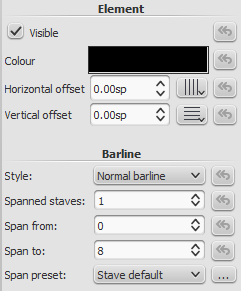
For details about how to adjust the properties of various score elements, refer to the relevant sections in the handbook. However, a few general points will be covered here:
Element
All score elements, except frames, breaks and spacers, display this category in the Inspector when selected. The various options are as follows:
-
Visible: Uncheck this box to make selected elements invisible: alternatively, use the shortcut V (toggle). Invisible elements do not appear in the music when printed out or exported as a PDF or image. If you still want them to remain on display in the document window, make sure that the "Show Invisible" option is selected in View → Show Invisible. Invisible elements will then be colored light gray.
-
Color: Click on the rectangle to open a "Color Select" dialog. Adjust the color and opacity of selected elements.
-
Horizontal offset / Vertical offset: Allows you to position selected elements exactly (in terms of space units). A positive number moves the elements right or down; a negative number moves the elements left or up. Snap to grid buttons are also provided.
Element Group
This category is displayed only when you have selected a mixture of different types of elements, and allows editing of color and visibility only.
Segment
This category is used to increase or decrease the space before/after an element in a music staff. Adjusting leading/trailing space here also affects any associated lyric syllables.
Chord
This category is displayed only if notes are selected. Any change to a notehead property under Chord affects the whole chord (i.e. all the notes in one voice) at that location—and not just the selected note. If you want to make changes to the position of just one note in a chord, then use the Element category (above).
Note
This category allows you to make changes to selected notes (but for note position—see Element). It contains the following properties:
- Small: Make notehead smaller (you can specify the relative size of all small notes from the menu: Style → General… → Sizes…).
- Head group: See Notehead groups.
- Head type: See Notehead types.
- Mirror head: Position notehead to the left or right of the stem (default is "Auto").
- Tuning: Adjust tuning of note to the nearest cent.
- Play: Unticking this box silences the note.
- Velocity type: Sets the MIDI velocity of notes directly. Chose one of two options:
- Offset: Make the value shown in "Velocity" relative to the previous dynamic marking.
- User: Make the value shown in "Velocity" absolute (i.e. the MIDI velocity is unaffected by dynamic markings).
- Velocity: Set the MIDI velocity according to the option displayed in "Velocity type."
- Fix to line: When ticked, the note is fixed to the top line of the standard 5-line staff.
- Line: A positive number moves the "fixed" note down; a negative number moves it upwards.
Select
This category appears differently according to the selection you have made:
- If you select a notehead, the "Select" category displays buttons which allow you to easily switch the selection to the stem, beam, hook, duration dot (or dots) or tuplet number associated with the notehead (see image below).

- If you select a range of measures, the "Select" category allows you to select either all notes, grace notes (from version 2.1) or rests.
Beam
This section is displayed in the Inspector when you select one or more note beams, and allows you to make fine adjustments to beam position and angle, and also change the spacing of beamed notes. See Adjust beam with the inspector.
Clef
This section appears when you select a clef: the tick box allows you to turn on/off the display of a preceding courtesy clef.

Properties dialogs
Properties of some objects are accessed by right-clicking on the object and choosing a "Properties" option from the context menu: these are in addition to the object's properties displayed in the Inspector.
(Note: Properties should not be confused with Styles. Changes to properties only affect the single element selected; all style controls apply to the entire score.)
Articulation properties
Right-click on an articulation and select Articulation Properties... See Articulations and ornaments.
Fretboard diagram properties
Right-click on a fretboard diagram and select Fretboard Diagram Properties... Allows you to create custom fretboard diagrams. See Edit fretboard diagram.
Line properties
Right-click on a line and select Line Properties... There are settings for the beginning, end, or continuation of the line. You can add or remove text, adjust the text's placement, and set the length and angle of optional hooks. Click the ... button to access text properties for text included in the line. See Custom lines and line properties.
Measure properties
Right-click on an empty part of the measure and select Measure Properties... Adjust visibility, bar duration, repeats, stretch and numbering. See Measure properties.
Staff properties
Right-click either an empty part of a measure or the name of an instrument and select Staff Properties... This dialog allows you to adjust attributes of both the single staff and the instrument it is a part of. See Staff properties.
Text properties
Right click on a text-based element and select Text Properties... See Text styles and properties. If the element is a line with text in it, see → above.
Time signature properties
Right-click on a time signature and select Time Signature Properties... Used to adjust appearance of time sig. and beam properties of notes. See Time signatures.
See also
| 附件 | 大小 |
|---|---|
| Note inspector.jpg | 67.14 KB |
| Staffproperties.jpg | 91.41 KB |
| Buttonstaffproperties.jpg | 1.03 KB |
| Staffproperties2ndaccess.jpg | 22.51 KB |
| View_en.png | 25.03 KB |
| Note inspector.png | 133.85 KB |
| Measure Properties 1.png | 53.21 KB |
| notes.png | 2.65 KB |
| inspector_select.png | 3.25 KB |
| Barline inspector.png | 10.85 KB |
| Measure Properties 2.png | 60.54 KB |
| inspector-top-bar.jpg | 3.08 KB |
| Previous_Next_Buttons.png | 7.36 KB |
| Staff_Properties_en.png | 30.14 KB |
| clef_inspector.png | 2.09 KB |
Measure operations
Note: To ensure that inserted or appended measures display correctly, multimeasure rests should be set to off (toggle M).
Select
Single measure
- To select a single measure, click on a space within the measure.
Range of measures
- To select a continuous range of measures, see Shift + click selection and Shift selection.
Insert
Insert an empty measure into the score
Use one of the following options:
- Select a measure or a frame, then press Ins (no shortcut on Mac).
- Select a measure or a frame, then chose from the menu: Add→Measures→Insert Measure.
Insert multiple measures
Use one of the following options:
- Select a measure or a frame, then press Ctrl+Ins (no shortcut on Mac); fill in the "Number of measures to insert" field and press OK.
- Select a measure or a frame, then chose from the menu: Add→Measures→Insert Measures...; fill in the "Number of measures to insert" field and press OK.
Append
Append an empty measure to the end of a score
Use one of the following options:
- Press Ctrl+B (Mac: ⌘+B).
- Select from the menu: Add→Measures→Append One Measure.
Append multiple measures to the end of a score
Use one of the following options:
- Press Alt+Shift+B (Mac: Option+Shift+B); fill in the "Number of measures to append" field and press OK.
- Select from the menu: Add→Measures→Append Measures...; fill in the "Number of measures to append" field and press OK.
Delete
Delete a single measure
- Select the measure;
- Press Ctrl+Del (Mac: Cmd+Del); or from the menu, select Edit→Measures→Delete Selected Measures.
Delete a range of measures
- Select the range of measures to delete;
- Press Ctrl+Del (Mac: Cmd+Del); or from the menu, select Edit→Measures→Delete Selected Measures.
Notes: (1) In multi-staff scores, measure deletion also removes all corresponding measures in the other staves of the system; (2) If you wish to delete only the measure contents (and not the measure itself), use the Del command instead at step "2."
Properties
To edit the properties of a measure, right-click an empty part of the measure and select Measure Properties...:
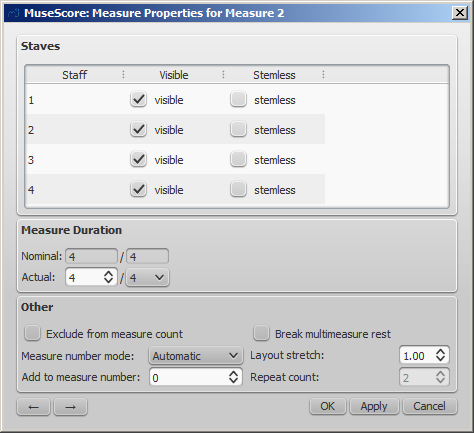
You can use the  buttons, at the bottom left of the dialog, to navigate to the previous or next measure.
buttons, at the bottom left of the dialog, to navigate to the previous or next measure.
Staves
- The visible property allows you to show/hide the notes and staff lines for the current measure.
- The stemless property allows you to show/hide all note stems for the current measure. Notes that normally have a stem such as half notes (minims) and quarter notes (crotchets) only show the note head when marked as stemless.
Measure duration
This feature allows you to adjust the time signature of a single measure regardless of the time signature indicated in the score. You can use it to create a pickup measure (also known as anacrusis or upbeat), cadenza, ad lib section etc.

- Nominal is the apparent time signature and cannot be edited.
- Actual can be set to anything you like regardless of the nominal time signature.
Example: In the image below, the quarter note pickup measure has a nominal time signature of 4/4, but an actual time sig. of 1/4. The measures in the middle are in normal 4/4 time. The complementary measure at the end of the staff, with a dotted half note, has an actual time sig. of 3/4.

Other
Exclude from measure count
Use "Exclude from measure count" for "irregular" measures, i.e. ones that should not get counted in the measure numbering. Normally, a pickup measure is marked as "Exclude from measure count".
Add to measure number
You can also use the "Add to measure number" option to influence the measure numbering. You can enter positive or negative numbers here. Please note that this affects all subsequent measures. A value of "-1" has the same effect as marking a measure to be excluded from measure count.
Layout stretch
You can increase or decrease horizontal space between score elements (notes, rests, etc.) with this option. This provides a more precise control over the exact same measure spacing property as the menu commands or keyboard shortcuts for Increase/Decrease Stretch ({ and }), which are accessed outside of the Measure Properties dialog while a measure is selected.
Play Count (as of version 2.1) / Repeat count (prior to version 2.1)
If the measure contains an end repeat barline, you can define how often it is played.
Break multi-measure rests
This property will separate a multi-measure rest at the start of the selected measure. This option should be checked before you turn on the "Create multi-measure rests" option in Style→General..., in the "Score" tab.
Multi-measure rests are automatically broken at important breaks, such as rehearsal marks, time signature changes, double barlines, irregular measures, etc. The default for scores is off, for parts is on.
Numbering
MuseScore automatically numbers the first measure of each System (except for the first system, actually except for a measure with the number 1), but more numbering options are possible. From the main menu, choose Style→General..., in the left pane, choose the "Header, Footer, Numbers" tab. At the bottom of the right pane is the "Measure Numbers" ("Bar Numbers") section.
Mark the checkbox next to the "Measure Numbers" ("Bar Numbers") to turn on automatic measure numbers.
Mark "Show first" if you want the first measure numbered.
Mark "All staves" if you want numbers on all staves. Otherwise, only the top staff of each system shows measure numbers.
Choose to show numbers on "Every system" which numbers the first measure of each line, or show numbers by "Interval" and specify the size of the interval. For example, an interval of 1 numbers every measure; an interval of 5 numbers every fifth measure.
Split and join
You may want have to have a longer or shorter measure without changing the time signature. You can change a measure's duration in Measure Properties, but there is now a new option to split or join measures. (Beams may be automatically modified.)
Join measures
- Select the measures you want to join;
- From the menu bar, select Edit→Measure→Join Selected Measures.
Note: If you select measures on only one staff in a score with multiple staves, the same measures will be joined in each staff of the system.
For example, the image below shows the result of applying the Join command to four measures in the top staff:
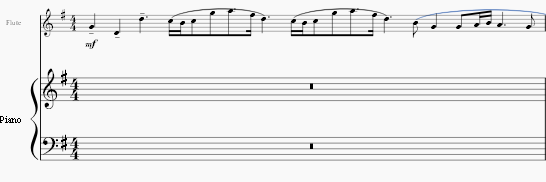
Split a measure
- Select a note (or chord);
- From the menu bar, select Edit→Measure→Split Measure Before Selected Note.
Note: If you select only one note from one staff, each staff of the system will be split at the same place.
External links
声部
声部指的是书写在同一谱表上的不同旋律进行。在其他制谱软件中,也会称为“层”。
在每个谱表上,您可以最多使用四个声部。在复合小节中,第一声部通常使用符干向上的音符,而第二声部通常使用符干向下的音符。

注意: 这一特性请不要与合唱作品中的“声部”混淆。合唱作品中的不同声部可以通过乐器对话框添加(按 I)。而在书写紧凑式的 SATB 合唱谱时,应该在第一行谱表使用第一声部书写女高音,使用第二声部书写女低音,在第二行谱表使用第一声部书写男高音,在第二声部书写男低音。绝对不要使用第三、四声部书写男高音和男低音。
何时使用声部
- 如果你需要在同一谱表的同一和弦中,将符干指向相反的方向。
- 如果你需要在同一谱表中使用的音符时值不同但却需要同时播放。
如何在不同声部中输入音符
下面会指导您如何输入两个声部的音乐段落:
- 首先输入第一声部的音符:确保您处于音符输入模式:而且工具栏中的 声部1 按钮处于高亮蓝色。首先输入最高声部的音符。输入的过程中,某些音符的符干会呈现向下的状态。没关系,添加第二声部之后,这些音符会自动翻转过去。
下图是只输入了第一声部的谱表:

-
将光标移回选中区域开头:输入完第一声部的音符之后,请重复按 ← 键以便移动光标,将其返回到乐段的第一个音符;或者使用 Ctrl+← (Mac:Cmd+←) 将光标一次向前移动一个小节。当然,您可以直接退出音符输入模式(按 Esc) 然后直接点击第一个音符。
-
输入第二声部:请确定您处于音符输入模式,并且选中了乐段第一声部的第一个音符。点击“声部2”按钮
 (位于工具栏右侧),或者使用快捷键 Ctrl+Alt+2 (Mac:Cmd+选项+2)。输入低声部(符干向下)的音符。
(位于工具栏右侧),或者使用快捷键 Ctrl+Alt+2 (Mac:Cmd+选项+2)。输入低声部(符干向下)的音符。
下图展示了输入第二声部之后的样子:

删除或隐藏休止符
尽管第二、三、四声部的休止符可以删除,第一声部的休止符是永远存在的。但是,如果需要的话,你可以将这些休止符隐藏,方法是将其设为不可见。要隐藏休止符,请选中它,然后按 V;或者取消检查器中的“可见”复选框 (参见可见性选项)。
交换音符所在的声部
要交换任意两个声部的音符:
- 选择一段小节;
- 从菜单中选择编辑 → 声部;
- 从列表中选择要交换的声部。
注意:(a) 选中内容可以包含任意声部中的音符,但是一次只能处理两个声部。(b) 即便您只选中了一小节中的部分内容,声部交换也仍然会在整个小节上发生。
将音符移至其他声部 (不进行交换)
您还可以将音符移至其他声部(无需进行音符交换):
- 确保你不在音符输入模式。
- 选择一个或多个符头(任何声部)。
- 点击音符输入工具栏中的目标声部,或者使用快捷键 Ctrl+Alt+1–4 (Mac:Cmd+选项+1-4)。
注意:要想成功移动,必须满足下列条件:
- 目标声部的和弦必须与要移动的音符时值相同。
- 目标声部有足够的休止时值以便容纳新音符。
- 音符没有被连音符所连接。
参见
外部链接
Copy and paste
MuseScore supports standard copy, cut, paste and (from version 2.1) swap with clipboard operations. These commands can be applied to a range of:
- Musical notes: e.g. to repeat a section of music, or shift a passage by a beat or a measure.
- Other score elements: such as articulations, staff text, dynamics, fingering etc.
Note: Lines cannot be copied but they can be duplicated (see below).
Copy/cut/paste/swap commands are accessed in three ways:
- From the Edit menu (above the document window).
- From the menu displayed by right-clicking on an element or range of elements.
- Using one of the standard keyboard shortcuts.
Summary of commands
| Command | Kbd Shortcut (Win) | Kbd Shortcut (Mac) | Right-click menu | Main menu |
|---|---|---|---|---|
| Cut | Ctrl+X | Cmd+X | Cut | Edit → Cut |
| Copy | Ctrl+C | Cmd+C | Copy | Edit → Copy |
| Paste | Ctrl+V | Cmd+V | Paste | Edit → Paste |
| Swap with clipboard | Ctrl+Shift+X | Cmd+Shift+X | Swap with Clipboard | Edit → Swap with clipboard |
Note: Before carrying out a copy, cut, paste or swap procedure, you should be in normal mode. Press the Esc key to exit into normal mode.
Notes
You can cut, copy, paste or swap notes as follows:
Copy or cut
To copy/cut a single chord
- Hold down Shift and click on a note in the chord.
- Apply a Copy or Cut option (see table above).
To copy/cut a range of chords
- Click on the first note or measure that you want to select.
- Shift+Click on the last note or measure that you want to select. A blue rectangle highlights the region you selected.
- Apply a Copy or Cut option (see table above).
Paste
- Click on the note or measure where you want your pasted selection to begin.
- Apply a Paste option (see table above).
Swap with Clipboard
Available from version 2.1 onwards, the swap with clipboard operation combines two commands into one: (1) First it overwrites a selected part of the score with the contents of the clipboard, just like the paste command; (2) Secondly, it transfers the overwritten part of the score back to the clipboard, just like the copy command.
It can be used, for example, to swap two equal-length sections of a score, A and B:
- Select section A, then apply the cut command;
- Clear the selection (by pressing Esc or clicking on a blank area of the document window);
- Press Shift and click on a note at the start of section B. Or, if B begins at the start of a measure, you can also simply select the measure;
- Apply a Swap with clipboard option (see table above).
- Section B is now in the clipboard. Paste it back to the blank area of score left by step "1."
Copy pitch of a single note only
It is possible to copy the pitch of a note only (and no other properties), by clicking on the notehead and applying the standard copy and paste, or copy and swap procedure. The pitch of the destination note changes to match that of the copied note but the duration remains the same.
Other elements
Score elements such as staff text, dynamics, fingering, etc. can be cut, copied and pasted one at a time (but from version 2.2 multiple-selection cut/copy/paste is possible for fretboard diagrams).
Multiple-selection cut/copy/paste is available for articulations such as sforzato, staccato etc.
Note: The Swap with clipboard command is only intended for use with sections of music and not other score elements.
Copy or cut
Paste
- Click on the note where you want your pasted selection to begin.
- Apply one of the Paste options (see table above).
In the case of articulations, they are pasted to the destination notes in exactly the same order (continuous or intermittent) as they were in the initial selection.
Quick repeat
To quickly copy and paste a note, measure, or passage:
- Select a chord, measure, or passage as described above.
- Press R .
MuseScore copies and pastes the selected notation to a point immediately after the last note in the selection. Any existing music in the destination range is replaced.
Duplicate
To instantaneously copy and paste a text element, line, or other object:
- Hold down Ctrl+Shift (Mac: Cmd+Shift), click on the element and drag it anywhere in the score.
- Release the mouse button, and the selected element is cloned to the new location.
Selection filter
The Selection Filter allows you to chose exactly which voices and elements you want to include in your selection.
- To display the Selection filter, press F6 (Mac: fn+F6); or from the menu, chose View→Selection Filter.
The Selection Filter appears by default below the Palettes. To change the viewing location, see Viewing and Navigation: Side panels.
Example: Suppose you want to copy measures 1 and 2 in the following passage (see image), to give measures 3 and 4:
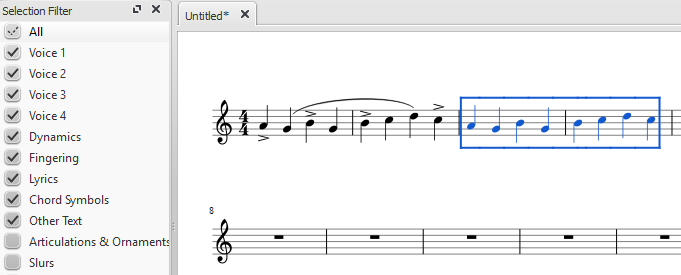
- Make sure the Selection Filter is displayed (see above);
- Uncheck the "Articulations & Ornaments" and "Slurs" tickboxes;
- Copy and paste the desired measures (in this example, 1-2 into 3-4).
Note: The Selection Filter works with the swap with clipboard command as well.
See also
If you want to change notes without altering the rhythm, you may combine transposition or re-pitch mode with copy and paste.
External links
Selection modes
Objects in the score—such as notes, measures, articulations etc.—can be selected in several ways: (1) one at a time, (2) as a continuous range, or (3) as a list.
Select a single object
Most score objects can be selected by simply clicking on them in "normal" (i.e. not note-input) mode.
Select a single note
- Make sure you are not in note input mode;
- Click on a note.
Note: Selecting a single note then copying and pasting it, will only copy and paste the pitch—not duration or other properties (such as stemless). To copy the entire note, including all properties, you need to hold down Shift—as for chord selection (below).
Select a chord
- Make sure you are not in note input mode;
- Press and hold Shift, then click on a note in the chord.
Select a single measure
- Click on a blank space within the measure.
Note: To select a range of consecutive measures, see Shift selection and Shift + click selection (below).
Select a continuous range of objects
There are several ways to select a continuous range of notes, chords or measures:
1. Shift selection
- Make sure you are not in note entry mode;
- Select the first note, chord, rest or measure in the range. You can extend the selection up or down to adjacent staves, if needed, using Shift+↑ or ↓;
- Then choose one of the following options:
- To advance the selection one chord at a time to the right: Press Shift+→.
- To advance the selection one chord at a time to the left: Press Shift+←.
- To advance the selection one measure at a time to the right: Press Shift+Ctrl+→ (Mac: Shift+Cmd+→).
- To advance the selection one measure at a time to the left: Press Shift+Ctrl+← (Mac: Shift+Cmd+←).
- To advance the selection to the beginning of the line: Press Shift+Home (Mac: Shift+Fn+←).
- To advance the selection to the end of the line: Press Shift+End (Mac: Shift+Fn+→).
- To extend the selection to the beginning of the score: Press Shift+Ctrl+Home (Mac: Shift+Cmd+Fn+←).
- To extend the selection to the end of the score: Press Shift+Ctrl+End (Mac: Shift+Cmd+Fn+→).
2. Shift + click selection
To select a range of notes or rests:
- Make sure you are not in note entry mode;
- Click on the first note or rest in the range;
- Press and hold Shift, then click on the last desired note or rest.
Note: The final selected element can be in the same staff or in staffs above or below the initial note/rest. All selected elements will be enclosed in a blue rectangle, including associated lines and articulations (but not voltas). You can repeat the operation to extend the selected range as required.
Select a range of measures
- Click on a blank space in the first desired measure;
- Hold down Shift, then click on a space in the last measure of the desired range.
Note: As with selecting notes, the range can be extended vertically as well as horizontally.
3. Drag selection
This method can be used to select notes or rests, or, independently, to select non-note symbols such as staccato dots, lyrics etc.:
- Press and hold Shift, then drag the cursor across the desired range.
4. Select All
This method selects the whole musical score including notes, rests and associated elements. Use one of the following options:
- Press Ctrl+A (Mac: Cmd+A).
- From the menu bar, select Edit → Select All.
5. Select section
This method is used to select a section—a region of the score starting and/or ending with a section break:
- Click on an empty space in a measure in the section;
- From the menu bar, select Edit → Select Section.
Note: See Copy and paste: Selection filter to disable certain types of elements from being selected in a range selection.
Select a list of objects
To select a list (or discontinuous range) of score elements:
- Click on the first element;
- Hold down Ctrl (Mac: Cmd) and successively click on the desired additional elements.
Note: This method cannot be used to select measures. Use single or range selection instead.
Select all similar
To select all elements of a specific type (e.g., all barlines, all text elements, all staccato markings):
- Select an element;
- Right click and chose Select…;
-
Several options are available:
- All Similar Elements: Selects all elements in the score similar to the chosen object.
- All Similar Elements in Same Staff: Selects all elements in the same staff similar to the chosen object.
- All Similar Elements in Range Selection: only applies if a range has been selected. Selects all elements in the range similar to the chosen object.
- More...: opens a dialog that lets you fine-tune more options. For example, if you have a notehead selected, the dialog will look something like this (as of version 2.1—previous versions had fewer options):
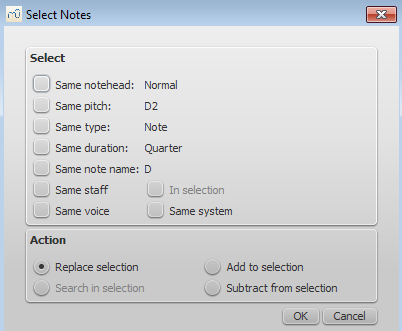
Select
- Same notehead: In this example, only noteheads of the same group will be selected;
- Same pitch: Only noteheads of the same pitch will be selected;
- Same type: All noteheads (of any group) will be selected;
- Same duration: Only noteheads of same duration will be selected;
- Same note name: Noteheads of that name in all octaves will be selected;
- Same staff: Only noteheads on the same staff will be selected.
Action
- Replace selection: The default option: starts the selection from scratch;
- Add to selection: Keeps everything you have already selected, and adds the current selection to it;
- Search in selection:
- Subtract from selection: Keep everything you have already selected, but takes away the current selection.
What selections are useful for
See also
- Basics chapter, esp. Note input
- Notation chapter, esp. Accidental
- Text chapter, esp. Text editing and Grid-based movement of symbols and staff text
Viewing and navigation
This chapter describes the options available in the View Menu, and in the Zoom and Page View/Continuous View menus (located in the toolbar above the score). It also details the various navigation commands and functions.
View menu
Show sidebars/panels
- Start center: F4
- Palettes: F9
- Master palette: Shift+F9
- Inspector: F8
- Play Panel: F11
- Navigator: F12
- Mixer: F10
- Synthesizer
- Selection filter: F6
- Piano keyboard: P
Zoom in/out
There are several ways to zoom the score in or out:
-
Keyboard shortcut:
- Zoom In: Ctrl++ (Mac: Cmd ++)
- Zoom Out: Ctrl +- (Mac: Cmd +-).
-
View menu:
- Zoom In: View→Zoom In
- Zoom Out: View→Zoom Out.
-
Mouse
- Zoom In: Scroll up with the mouse wheel while holding down Ctrl (Mac: Cmd)
- Zoom Out: Scroll down with the mouse wheel while holding down Ctrl (Mac: Cmd).
-
Drop-down menu: To set a specific zoom, use the dropdown menu in the standard toolbar to set the view magnification of the score (25–1600 %) or display it using the options "Page Width", "Whole Page", or "Two Pages".
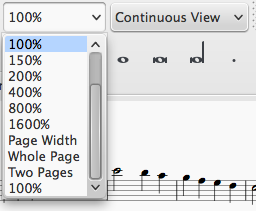
-
To return to 100% zoom: Use the shortcut Ctrl+0 (Mac: Cmd+0).
Toolbars (display)
As of MuseScore 2.1, this menu option allows you to hide or display the toolbars above the document window: File Operations, Playback Controls, Concert Pitch, Image Capture, Note Input (see Toolbars below).
Show Status bar
The Status bar, at the bottom of the screen, gives information about selected score elements. Tick/untick this option to display or hide.
Split display
It is possible to split the document display so as to view two documents at once, or to view two different parts of the same document. Tabs allow you to choose which document to display in each view. You can drag the barrier separating the two scores to adjust the amount of space in the window devoted to each:
- Documents Side by Side: Divides the window vertically into two score views.
- Documents Stacked: Divides the window horizontally into two score views, one above the other.

Visibility options
This section allows you to display or hide various non-printing elements:
- Show Invisible: View/hide elements that have been made invisible for printing and export. If this option is ticked, invisible elements are shown in the score window as light gray.
- Show Unprintable: View/hide breaks and spacer symbols.
- Show Frames: View/hide the dotted outlines of frames.
- Show Page Margins: View/hide Page Margins.
Full screen
Full Screen mode expands MuseScore to fill your screen so more content is visible.
Page/Continuous View
You can switch between two different views of the score using the drop-down list in the toolbar area:

To scroll the score:
- Vertically: Move the mouse wheel up or down.
- Horizontally: Press Shift and move the mouse wheel up or down.
Page View
In Page View, the score is formatted as it will appear when printed or exported as a PDF or image file: that is, page by page, with margins. MuseScore applies system (line) and page breaks automatically, according to the settings made in 页面设置 and Style: General. In addition, you can apply your own system (line), page or section breaks.
To choose between horizontal or vertical page scrolling, see Preferences: Canvas (Scroll pages).
Continuous View
In Continuous View, the score is shown as one unbroken system. Even if the starting point is not in view, measure numbers, instrument names, clefs, time and key signatures will always be displayed on the left of the window.

Note: Because the layout is simpler, MuseScore may perform faster in Continuous View than Page View.
Toolbars

The Toolbar area is located between the Menu bar and document window. It contains symbols which allow you to perform certain operations. It can be divided into the following toolbars:
- File Operations: New score, Load score, Save, Print, Undo, Redo.
- Zoom/Page View.
- Playback controls: Enable MIDI, Rewind, Play/Stop, Loop, Play Repeats, Metronome.
- Concert Pitch: Displays score in written or concert (sounding) pitch.
- Image Capture: Allows you to take a snapshot of part of the score.
- Note Input: Note entry mode, Duration, Tie, Rest, Accidentals, Flip stem direction, Voice (1, 2, 3, 4).
To choose which toolbars to display, right-click on an empty space in the toolbar area (or on the title bar of the Inspector) and, from the menu, check or uncheck the required options. This menu also allows you to view or hide the Piano keyboard, Selection sidebar, Palettes, the Inspector, and (if already displayed) the "Drum Tools" (i.e. Drum input palette).
These display options can also be accessed in the View menu, and, as of 2.1, in View→Toolbars.
Side panels
The workspaces, Inspector and Selection filter are conveniently displayed as side panels to the left and right of the score window. To undock a side panel use one of the following methods:
- Drag the panel;
- Click on the double chevron at the top of the panel;
- Double click in the title area at the top of the panel.
To dock a panel use one of the following procedures:
- Drag the panel to the top/bottom of an existing side panel and it will stack vertically above/below that panel.
- Drag the panel to the middle of an existing side panel and it will overlay that panel. Both panels can then be accessed by tabs.
Alternatively, double-clicking the title bar of the panel will restore it to its previously docked position.
Navigation
There are various commands available to help you navigate through the score. These are listed under Keyboard shortcuts: Navigation.
Navigator
The Navigator is an optional panel which allows you to navigate a long score more easily, or go to specific pages. To view/hide, go to the View→Navigator, or use the shortcut F12 (Mac: fn+F12). It appears at the bottom of the document window if scrolling pages horizontally, or on the right-hand side of the document window if scrolling pages vertically (see Preferences: Canvas).

The blue box represents the area of the score that is currently visible in the main window. You can drag either the blue box or the scroll bar, or click on an area to immediately go to it.
Find
The Find function allows you to speedily navigate to a specific measure, rehearsal mark or page number in the score:
- Press Ctrl+F (Mac: Cmd+F), or select Edit→Find. This opens the Find (or Go to) bar at the bottom of the workspace.
-
Use one of the following options:
- To go to a numbered measure: enter the measure number (counting every measure, starting with 1, irrespective of pickup measures, section breaks or manual changes to measure number offsets).
- To go to a numbered page: enter the page number using the format pXX (where XX is the page number).
- To go to a numerical rehearsal mark: enter the number using the format rXX (where XX is the name of the rehearsal mark (as of version 2.1).
- To go to a rehearsal mark starting with a letter: enter the name of the rehearsal mark (the search is case insensitive).
N.B.: It is best to avoid naming rehearsal marks with the single letters "R," "r," "P", "p," or one of these letters with an integer (e.g. "R1" or "p3"), as this can confuse the search algorithm.
See also
Open/Save/Export/Print
In the File menu you can find the following options:
- Open, Open recent.
- Save, Save As..., Save a Copy..., Save Selection..., Save Online...
- Export..., Export Parts...
-
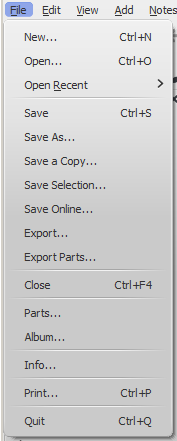
Open
Apart from native format files (*.mscz and *.mscx), MuseScore can also open MusicXML, compressed MusicXML and MIDI files, as well as a variety of files in other formats.
To open any supported file:
- Chose one of the following options:
- Press Ctrl+O.
- Click on the "Load score" icon on the left side of the toolbar area.
- From the menu bar, select File→Open....
- Select a file and click Open; or simply double-click a file.
Open recent… allows you to chose from a list of recently-opened scores.
Save
Save…, Save As…, Save a Copy… and Save Selection… allow you to save native MuseScore files (.mscz and .mscx).
- Save...: Save current score to file.
- Save As...: Save current score to new file.
- Save a Copy...: Save current score to new file, but continue to edit original file.
- Save Selection...: Save selected measures to new file. In MuseScore versions earlier than 2.1, to ensure that the file is saved correctly, the time signature needs to be displayed in the first measure of the selected passage, unless it is 4/4.
- Save Online...: To save and share your scores on the web at MuseScore.com. For details, see Share scores online.
Export
Export... and Export Parts... allow you to create non-MuseScore files, such as PDF, MusicXML, MIDI, and various audio and image formats. In the Export dialog, you can choose which format to export to:
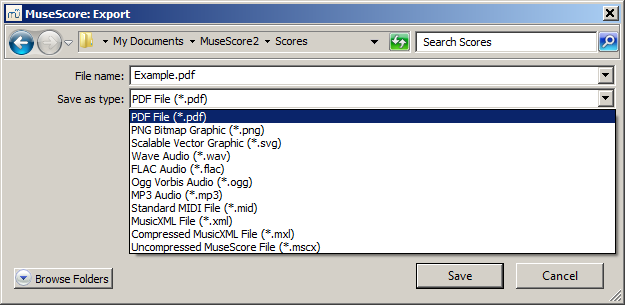
- Export...: Export current score to format of your choice.
- Export Parts...: Export current score and all linked parts to separate files in a format of your choice.
MuseScore remembers which format you picked the last time and makes that the default for the next time. Note: There is a known issue with Windows XP and Vista, where you have to manually (un)set the filename's extension when choosing a different format than the one selected the previous time.
Print... allows to print your MuseScore file directly to a printer from MuseScore. Depending on your printer you will have different options, but generally you can define the page range, number of copies and collation.
If you have a PDF printer installed, you could also "export" to PDF using Print, but it's usually better to use the native PDF option under Export for more accurate rendition. Note: For this to work properly with Adobe PDF, make sure to uncheck "Rely on system fonts only, do not use document fonts" in Printer properties.
See also
撤销与重做
MuseScore 能够记住无限次的撤销和重做。
标准快捷键是:
- 撤销 Ctrl+Z (Mac: ⌘+Z)
- 重做 Ctrl+Shift+Z or Ctrl+Y (Mac: ⌘+Shift+Z)
或者使用工具栏按钮:
Share scores online
Go to musescore.com/sheetmusic to view other scores from MuseScore.
You can save and share your scores online at MuseScore.com. You can choose to save a score privately for personal access from any computer, or share it publicly. MuseScore.com enables the viewing and playback of scores in your web browser - an additional feature entitled VideoScores allows synchronization between the score and a YouTube video. For use outside of a web browser, you can download the score in a variety of formats (including PDF, MIDI, MP3, MusicXML, and the original MuseScore file).
Create an account
- Visit MuseScore.com and click on "Create new account". Pick a username and enter a valid email and press "Create New Account".
- Wait a few minutes for an email from MuseScore.com support. If no email arrives, check your spam folder.
- Click the link in the email and visit your user profile to change your password.
Share a score directly from MuseScore
To save a score online:
- Make sure that the Concert Pitch button is off, and that the individual parts are correctly transposed.
-
From the menu, select File→Save Online.... The "Log in to MuseScore" dialog will appear:
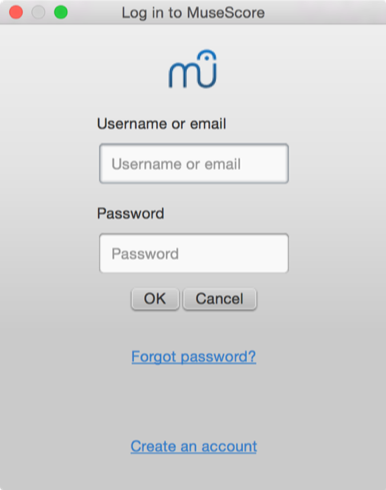
-
Enter your email address or MuseScore username, and password, then click OK. Note: If you don't have a MuseScore account yet, create one first by clicking on the "Create an account" link. That will open your browser app and bring you to musescore.com/user/register.
-
Upon successfully logging in, you'll be able to enter your score information.
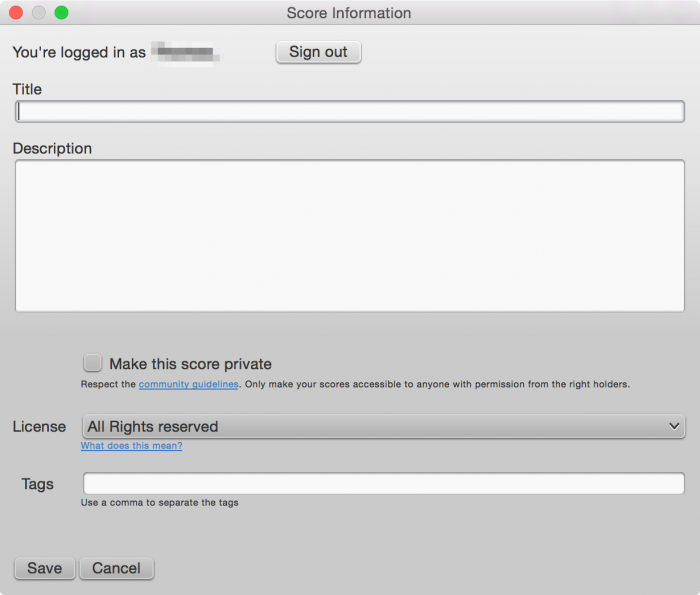
- Title: The title of the score.
- Description: The descriptive text that will appear next to it.
- Make the score private: If ticked, the score can only be viewed via a private link. If unticked, the score is visble to all.
- License: Chose an appropriate copyright license from the drop-down list. Note: Creative Commons license, allows people to use your scores under certain restrictions.
- Tags: You can add tags to help identify scores on MuseScore.com. Use commas to separate multiple tags.
-
In case you already saved the score online earlier, it will automatically update the existing one, and, as of version 2.1, you can enter some additional information in a changlog section of the dialog, which you can then retrieve on MuseScore.com under "Revision history" for that score. Uncheck Update the existing score to save online as a new score.

-
(As of version 2.1) If you are using a different SoundFont than the default one and if you are able to export MP3 files, a checkbox Upload score audio will be visible:

If the checkbox is checked, MuseScore will render the audio of the score using the current synthesizer settings and upload the audio to MuseScore.com.
Upload a score on MuseScore.com
You can also upload a score directly on MuseScore.com.
- Click the Upload link on MuseScore.com.
- You have the same options as with the Save Online menu.
- You have also access to more information, such as Genre.
Note: Should you reach the five score upload limit, you can still upload scores directly from MuseScore, but only the last five are visible. If you wish more than this amount, upgrade to a Pro Account first.
Edit a score on MuseScore.com
If you want to make changes to one of your scores on MuseScore.com, edit the MuseScore file on your own computer, save it, and then do the following:
- If you originally shared the score directly from within MuseScore, simply go to File→Save Online... again to update the online score.
- If you originally uploaded the score via the Upload page on MuseScore.com, then you must follow these steps to update the online score:
- Go to the score page on MuseScore.com.
- Click the three dots menu ⋮ on the right and choose "Update this score".
- In the form, you can upload a replacement score file as well as change the accompanying information and privacy settings.
Switch to the direct method of updating an online score
It is much more convenient to update online scores from directly within MuseScore than by updating the score manually from the score page. Follow these steps if you originally uploaded the score via the Upload page and now want to switch to the direct method:
- Go to the score page on MuseScore.com and copy the URL.
- Open the score file on your computer with MuseScore.
- From the menu, select File→Score Properties... and paste the URL into the "Source" field.
Now whenever you want to update the online score simply go to File→Save Online....